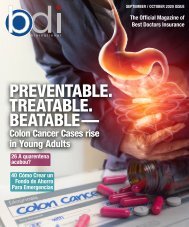BDI International Magazine - March/April Issue
The Official Magazine of Best Doctors Insurance.
The Official Magazine of Best Doctors Insurance.
You also want an ePaper? Increase the reach of your titles
YUMPU automatically turns print PDFs into web optimized ePapers that Google loves.
system. This system builds a replica of a<br />
cancerous tumor for a period of six hours.<br />
Their goal is to test different drugs and<br />
treatments in various doses to see which<br />
one works the best. After the lab testing,<br />
the patient will actually receive a tailormade<br />
treatment program. This method<br />
would decrease the side-effects and<br />
increase the chances of survival.<br />
3D printing is a very promising method for<br />
the health care system and for human lives.<br />
• DLAD and LYNA<br />
DLAD stands for a Deep Learning-based<br />
Automatic Detection algorithm.<br />
Researchers from Seoul National<br />
University Hospital and College of<br />
Medicine had developed the DLAD AI<br />
algorithm to analyze chest radiographs<br />
and detect abnormal cell growth, like<br />
potential cancers.<br />
After this algorithm, a second one called<br />
LYNA (Lymph Node Assistant) was<br />
developed by researchers at Google AI<br />
Healthcare. This algorithm analyzes<br />
histology slides stained tissue samples in<br />
order to differentiate metastatic breast<br />
cancer tumors from lymph node biopsies.<br />
The LYNA algorithm can identify<br />
suspicious regions that are not<br />
distinguishable to the human eye in the<br />
biopsy samples. LYNA passed the tests on<br />
two data sets and showed 99% accuracy<br />
with cancerous and noncancerous<br />
samples. With LYNA’s help, the average<br />
slide review time is now halved.<br />
It is predicted that the role of artificial<br />
intelligence in medicine will continue to<br />
grow drastically. But experts and<br />
researchers warn that the growth must be<br />
step by step, since the machines’ “brains”<br />
are not thinking logically like the human<br />
brains.<br />
The key to creating an algorithm that will<br />
be functional and practical in medicine is<br />
a real understanding of the possibilities<br />
by physicians. As much as the algorithm<br />
might seem perfect, errors are always<br />
possible that can be solved and improved<br />
by the widespread audience. Setting up<br />
stable relationships between doctors that<br />
have the knowledge and the programmers<br />
that create the algorithms, it will be less<br />
likely for an algorithm to learn to make<br />
incorrect choices.<br />
Implementing artificial intelligence in<br />
medicine is a real challenge, but it is worth<br />
trying in order to increase the accuracy<br />
and efficiency of medical practices for<br />
numerous diseases.<br />
The only question that can’t be answered yet<br />
is, How much longer can we possibly extend<br />
human lives by replacing body parts?<br />
<strong>BDI</strong> <strong>International</strong> <strong>Magazine</strong> | Page 8
















